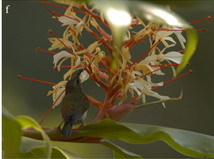Both Hedychium villosum (tetrapolid) and H. tenuiflorum (diploid) are epiphytic small gingers with robust fleshy rhizomes. The two varieties were recognized as distinct species because of discernible morphological characters, distinct geographic ranges and habitats, and complete reproductive isolation.
To better understand the success of polyploid taxa in nature, and to assess the influence of polyploidisation on reproductive divergence,Prof. GAO Jiangyun and his colleagues of Xishuangbanna Tropical Botanical Garden (XTBG) compared the floral biology and breeding systems of the two closely related species (the tetraploid species Hedychium villosum and its diploid progenitor H. tenuiflorum). Their study addressed three main questions: (i) what is the differentiation in reproductive traits of the two species; (ii) what are the compatibility systems of the two species; and (iii) is there differentiation in assemblage of insect visitors to the two species?
Their study found that flowers of the tetraploid species, H. villosum lasted longer and produced more nectar than did diploid species, H. tenuiflorum. The flowering times of the two species did not overlap at all. Observations of floral visitors in natural populations demonstrated that butterflies and hawkmoths were effective pollinators of both species, but there was a significant difference in butterfly and hawkmoth assemblages between the two species. The hand-pollination experiments and pollen tube growth experiments suggested that diploid H. tenuiflorum was self-incompatible, while tetraploid H. villosum was completely self-compatible. H. villosum had a much wider distribution range and occupied more diverse habitats than H. tenuiflorum. Polyploidisation might enable tetraploid H. villosum to exploit new habitats previously unavailable to diploid H. tenuiflorum.
The study entitled “The comparative reproductive biology of a tetraploid species, , and its diploid progenitor (Zingiberaceae)” has been published online in Plant Biology.


